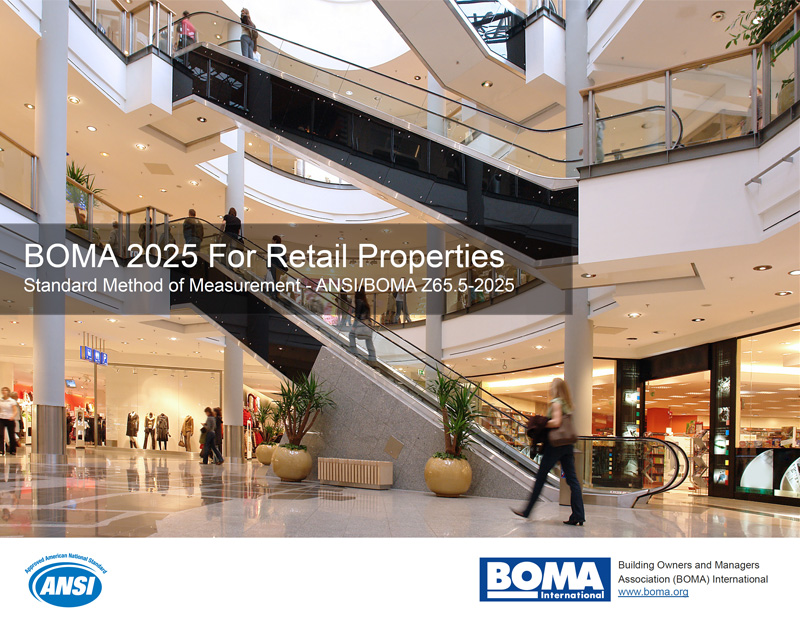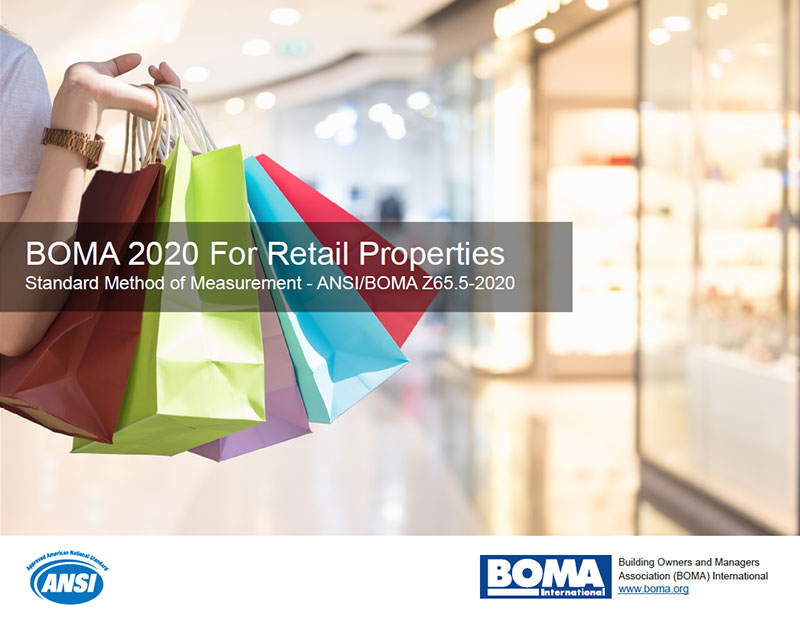This help desk is intended for discussion purposes only. Neither BOMA, its chapters, affiliates, nor Extreme Measures Inc.® are responsible for the information, comments, or opinions expressed herein. For complete information, please refer to the official publications of the standards themselves.
Help Desk Contents
- BOMA Standards Q&A Forum
- Building Measurement Glossary
- BOMA Office Standards Overview
- BOMA Industrial Standards Overview
- BOMA Retail Standards Overview
- BOMA Multi-Family & Hospitality Standards Overview
- BOMA Mixed-Use Overview
- BOMA Gross Areas Overview
- IPMS: All Buildings Standard Overview
- Alternative Measurement Methods
- Where to Get Measurement Standards Publications
- What are As-Built Drawings?
- Intro to CAD, BIM & Digital Twins
- Resolving Area Measurement Disputes Between Tenants and Landlords
BOMA Retail Measurement Standards
- Introduction
- BOMA Retail 2025
- BOMA Retail 2020
- BOMA Retail 2010
Overview
The BOMA Retail Standard was first published in 2010 to give building owners, property managers, and commercial real estate professionals a consistent, repeatable methodology for measuring retail space. Revised in 2020 and 2025, the standard continues to evolve with the needs of the retail property industry. To ensure accuracy and compliance, BOMA strongly recommends using the latest edition of the Retail Standard. However, earlier versions are still encountered in practice, particularly when reviewing lease agreements, contracts, and historical measurement documentation.
Unlike the BOMA Office and Industrial Standards, which use “Rentable Area,” the Retail Standard defines Gross Leasable Area (GLA) as its core metric. GLA is the foundation for retail leasing, valuation, and transactions, making it essential for shopping centers, strip plazas, malls, and mixed‑use retail developments.
Today, the BOMA Retail Standard is recognized worldwide as the authoritative method of measurement for retail properties, widely adopted across the United States, Canada, and international real estate markets.
Purpose & Application
The primary purpose of the BOMA Retail Standard is to establish a clear methodology for determining the Gross Leasable Area (GLA) of tenant spaces in retail properties. GLA represents the actual area leased to an occupant and does not include a proportionate share of common service or amenity areas. This distinction is critical in retail leasing, property valuation, and commercial real estate transactions, as GLA provides a consistent basis for calculating rent, structuring lease agreements, and comparing retail units across different properties. By standardizing how GLA is measured, the BOMA Retail Standard ensures transparency and accuracy for landlords, tenants, brokers, and property managers working with shopping centers, strip plazas, malls, and mixed‑use retail developments.
Extreme Measures is the Editor and Illustrator of the BOMA Retail 2025 and BOMA Retail 2020 Industrial Standard.
BOMA 2025 for Retail Properties Standard Method of Measurement - ANSI/BOMA Z65.5-2025
In 2025, BOMA International released the updated BOMA 2025 Retail Standard, building on the foundation of the 2020 edition with improved clarity and usability. While not considered a major overhaul, this version is strongly recommended for its intuitive terminology, expanded illustrations, new Special Conditions, and updated definitions, making it the most practical edition for modern retail property measurement.
One of the most notable changes in the 2025 Retail Standard is the reorganization of key terms. In the 2020 edition, “Gross Leasable Area” was the primary space classification, further divided into “Occupant Area” and “Leased Kiosks.” In the 2025 edition, however, Gross Leasable Area (GLA) refers only to the actual leased areas of occupants, aligning more closely with terminology commonly used in lease agreements. “Occupant Area” has been replaced with Retail Units, and “Tenanted Areas” is now the primary classification, comprising both Retail Units and Leased Kiosks. These changes are reflected throughout the document and in the Global Summary of Areas.
The Global Summary also clarifies that the Boundary Area can serve as the Single Occupant GLA, but this requires an Overall Measurement of the retail building rather than a Partial Measurement. Additional updates include a methodology for measuring vertically aligned, stacked staircases, which are often found in smaller, street‑level retail properties.
The 2025 edition also introduces new Special Conditions to resolve ambiguities from earlier versions:
- Drive-Throughs: guidance on measuring areas designed for customer transactions from vehicles, such as gas stations, restaurant drive‑throughs, and ATMs.
- Perimeter Columns: clarifies how boundary areas are established along the building enclosure.
- Unexcavated Areas: specifies that unconstructed spaces within a retail property are excluded from boundary calculations.

BOMA 2020 for Retail Properties Standard Method of Measurement - ANSI/BOMA Z65.5-2020
In 2020, BOMA International released BOMA 2020 for Retail Properties: Standard Method of Measurement (ANSI/BOMA Z65.5-2020), a more comprehensive and flexible update to the original retail standard. This edition followed the formatting and illustrative style introduced in the BOMA 2017 Office Standard and the BOMA 2019 Industrial Standard, ensuring consistency across property types.
The 2020 Retail Standard expanded and clarified many concepts from its predecessor, introducing several important new features. One of the most significant was the ability to perform either a Partial Measurement or an Overall Measurement of a retail property. While measuring the entire building is recommended, this flexibility allows property managers and surveyors to measure individual retail units, reducing the workload when a full building measurement is not required.
Another major enhancement was the introduction of the Retail Experience concept, which allows certain qualifying unenclosed areas to be included in measurement. This addition made the standard more adaptable to open‑air shopping centers, outdoor malls, and lifestyle retail developments, helping landlords account for outdoor amenities in budgeting and planning.
The 2020 edition also introduced a methodology for allocating Parking Areas, Major Vertical Penetrations, and Service/Public Areas—collectively referred to as Gross Leasable Exclusions. These allocations are calculated based on each occupant’s GLA but are not applied as traditional “gross‑ups” or “load factors.” Instead, they are treated as standalone areas associated with individual tenants. This approach helps landlords manage common area maintenance (CAM) charges, property taxes, and operating expenses more effectively.
With these improvements, the BOMA 2020 Retail Standard became a more versatile and practical framework for retail property measurement, leasing, and management, aligning with evolving industry needs.
Extreme Measures is the Editor and Illustrator of the BOMA 2020 Retail Standard.BOMA 2010 for Retail Properties Standard Method of Measurement - ANSI/BOMA Z65.5-2010
In 2010, BOMA released Retail Buildings: Standard Methods of Measurement (ANSI/BOMA Z65.5-2010), the first standard dedicated exclusively to retail property measurement. While earlier Office Standards from 1980 and 1996 included limited provisions for retail spaces within office buildings, the 2010 Retail Standard marked a significant milestone by focusing entirely on retail environments such as shopping malls, strip plazas, big box stores, and outparcel tenancies.
Unlike office measurement methodologies, the 2010 Retail Standard did not apply a proportionate allocation of common areas to occupants (commonly known as a “gross‑up” or “load factor”). Instead, it concentrated on defining and calculating the Gross Leasable Area (GLA) of each tenant space. The document provided detailed guidance on how GLA should be measured, including rules for building perimeters, measure lines, and lease lines. Generally, the gross area of an occupant was measured to the exterior face of most walls, while demising walls were measured to the centerline.
The 2010 edition also offered specific instructions for measuring unique retail elements such as mezzanines, kiosks, food courts, and parking facilities, ensuring consistency across diverse property types. This standard established BOMA as the authoritative source for retail space measurement in commercial real estate, laying the foundation for subsequent updates in 2020 and 2025.